Gigabyte K8NNXP-940: Built on Athlon64 FX51 Strengths
by Wesley Fink on October 9, 2003 11:52 PM EST- Posted in
- Motherboards
Gigabyte K8NNXP-940: Basic Features
| Motherboard Specifications | |
| CPU Interface | Socket-940 Athlon64 FX |
| Chipset | nForce3-150 Single-Chip |
| Bus Speeds | 200MHz to 300MHz (in 1MHz increments) |
| PCI/AGP Speeds | Auto (Variable) or Fixed 66-100MHz (in 1 MHz increments) |
| Available CPU Ratios | Auto, 4X to 25X in 0.5 increments |
| Core Voltage | Normal, 0.80V to 1.70V in 0.025v increments |
| DRAM Voltage | Normal, +.1, +.2, +.3V |
| Chipset (VDDQ) Voltage | Normal, +.1, +.2, +.3V |
| Hypertransport (VCC12_HT) Voltage | Normal, +.1, +.2, +.3V |
| Memory Slots | Four 184-pin DDR DIMM Slots Dual-Channel Configuration For Registered/Registered ECC |
| Expansion Slots | 1 AGP 8X Slot 5 PCI Slots |
| Onboard Serial ATA RAID | Silicon Image Sil3112 supports Raid0/1 |
| Onboard IDE RAID | Two Standard ATA133/100/66 Plus 2 GigaRAID ATA133 IDE RAID |
| Onboard USB 2.0/IEEE-1394 | Six USB 2.0 ports supported by nF3 TI 1394B (800 Mb/s) FireWire (2 ports) |
| Onboard LAN | Two ports, Realtek Gigabit LAN + Realtek 10/100 LAN |
| Onboard Audio | Realtek ALC658 codec AC '97 2.3 6-Channel with UA |
| BIOS Revision | F1 Release 7/22/2003 |

The Gigabyte K8NNXP-940 is Gigabyte's top board for the Athlon64 Enthusiast, and the fancy embossed foil packaging tries to convey that. This is typical of recent Gigabyte top-line boards.

Gigabyte continues the recent “6-Dual Miracle” theme with the K8NNXP-940, with the Dual 32-bit/64-bit Dual CPU bandwidth replacing Hyperthreading as Athlon64's Dual. As the flagship for the Gigabyte AMD line, every feature you can imagine is lavished on the K8NNXP-940. The most significant new addition is 1394b Firewire. This is the first board that we have tested with the new 800Mb/s firewire.
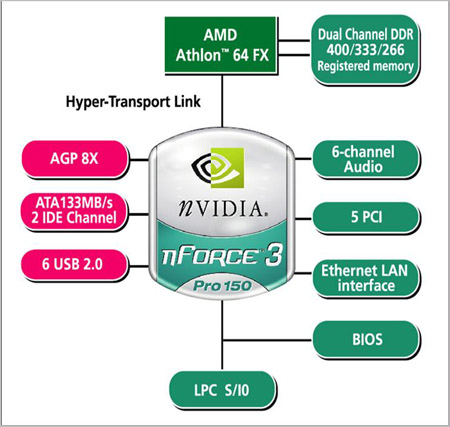
Gigabyte uses the nVidia nForce3-Pro150 single-chip solution on the K8NNXP-940. While the nF3-150 and nF3-Pro150 are currently limited to 600MHz HyperTransport, communication to the FX processor is direct and not bottlenecked by slower speed chip communications in traditional north/south bridge chipsets. The nF3-150 is used on motherboards designed for the single-channel Socket 754 Athlon64, while the nF3-PRO150 is designed for the Dual-Channel Opteron or Socket 940 FX51.
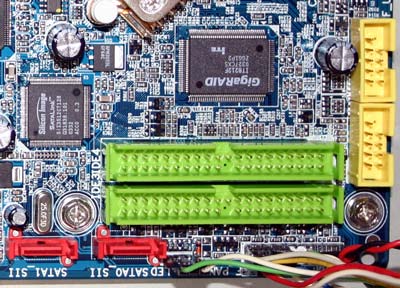
The Gigabyte uses both the GigaRAID IDE RAID based on the IT8212 chip and SATA RAID based on the well-regarded Silicon Image 3112/3512 chip. IDE RAID 0, 1, 0+1 are supported, and SATA RAID 0, 1. A full assortment of SATA/IDE cables and SATA/Molex power connectors are provided for drive hookup.

This includes Gigabytes unique external SATA bracket that allows connection of 2 external Serial ATA devices.

K8NNXP-940 uses the newest and best version of the Realtek audio codec called ALC658. This audio chips features Dolby Digital 6-channel sound and UAJ or Universal Audio Jack. This allows automatic jack programming as we've seen on some boards based on Intel's 865/875 chipsets.

If you have Dolby digital capabilities, SPDIF output is provided by an included SPDIF bracket. SPDIF out jacks are provided for both optical and coaxial connections, as well as the 2 additional jacks for rear speakers in a powered 4 to 6 speaker arrangement. This allows rear speakers/subcenter to be used, while still leaving usable microphone and audio input capabilities. Many motherboards must program the rear-panel jacks and use the mic and input jacks for a 6-speaker setup. The ability to use six speakers, mic, and audio input is a nice feature — and more unique than you might imagine.
Realtek markets the ALC658 as a premium sound solution, and their first 2.3 compliant audio codec. The ALC658 is:
The ALC658 has six 20-bit DAC channels, two pairs of stereo 18-bit ADC, and an AC'97 2.3 compatible six-channel audio CODEC designed for PC multimedia systems. The ALC658 incorporates proprietary converter technology to achieve 100dB sound quality, meeting performance requirements on PC99/2001 systems and placing PC sound quality at the same level as consumer equipment.More information on the features and specifications of ALC658 is available at Realtek.

In addition to the 2 USB 2.0 ports on the rear I/O panel, Gigabyte provides an accessory bracket with two more USB 2.0 ports and 2-800mb/sec Firewire ports (one standard and one mini). An additional 2-port USB2.0 bracket is provided if needed. It is clear that the designers put some thought into this arrangement, since many users have front USB ports on their cases and the combo USB/firewire bracket may be their only added ports.
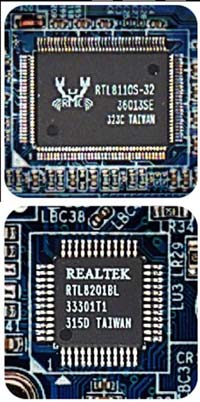
In keeping with the Dual theme, the K8NNXP-940 includes two LAN ports — a Gigabit LAN port and a 10/100 Ethernet port. Both chips are by Realtek.
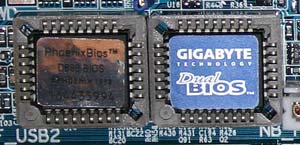
Gigabyte uses their trademark Dual BIOS on their mid- to high-end motherboards, and it is included on the K8NNXP-940. In addition to protection from a bad BIOS flash, the dual BIOS feature allows the creative end-user to set up 2 different BIOS setups for different OS or loads. In addition, the dual BIOS has hooks to allow direct flashing of the BIOS without an OS. You merely copy the BIOS file to a floppy, hit DEL during boot to enter BIOS, hit F8 to enter BIOS setup and make selections. Updating BIOS is as easy as it gets.

The K8NNXP I/O ports configuration is the assortment you will find on most high-end boards, and a custom ATX backplate is included.
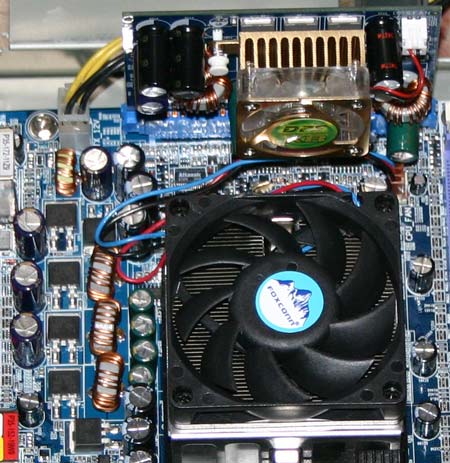
As part of their Dual Power and Dual Cooling features, Gigabyte includes the DPS-K8 power module. The base K8NNXP-940 is a 3-phase board, while adding the DPS-K8 module extends the board to 6-phase power and a second cooling fan. Gigabyte claims that the 6-phase power produces a more stable motherboard, better overclocking, and longer lasting components.
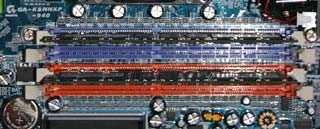
Four DIMM slots support Registered or Registered ECC Dual-Channel memory. Memory should be installed in matched pairs for Dual-Channel. Regular unbuffered DDR memory will not work in FX51 boards or in Opteron boards. Memory up to DDR400 is officially supported, which is an improvement over the DDR333 support that we have seen in past Opteron nForce3 boards.










35 Comments
View All Comments
juc - Friday, October 10, 2003 - link
can you try and put in a lower clock opteron and see what type of overclocking you can do w/ it?, is the regular 14x opteron unlocked? it would be nice if it was.Reflex - Friday, October 10, 2003 - link
#1: A RDRAM version would completely eliminate the advantage of having an on-die memory controller on the CPU as it is very very high latency by design. The A64 thrives on very very low latency/high IPC, and RDRAM does not provide that.Honestly, what would be truly ideal is a QDR solution. But everytime I hear about it being close nothing seems to come of it. Too bad...
Anonymous User - Friday, October 10, 2003 - link
Considering the performance gain, money ain't that important :-)Anonymous User - Friday, October 10, 2003 - link
#1,Samsung PC-3200 512 MB DDR SDRAM $125
Samsung PC-3200 512 MB ECC Reg. DDR SDRAM $174
+49
Corsair XMS3200 PC-3200 512MB DDR SDRAM $175
Corsair XMS3200 PC-3200 ELL 512MB DDR SDRAM $220
Corsair XMS3200LL-RE PC-3200 ECC Reg. 512MB DDR SDRAM $235
+15 (+60 compared to slower timings)
completely unmeaningful to anyone with the money to buy an fx.
Anonymous User - Friday, October 10, 2003 - link
Looks like a cool mobo, and an amazingly fast CPU, but . . .Who's going to buy one of these!?!?!?
The price you'll spend on memory put's this way out of most people's price range! And before you yell at me for saying that, look up pricing for registered modules!
You could probably buy an awesome Athlon 64 system now, then upgrade your mobo and CPU to FX when the 939 pin version comes out, and still spend less money than paying this ridiculous premium on memory. Plus, it would be upgradable to future FX chips, not an unsupported beast. Anyone remember socket 423?
Say goodbye to the idea of 'surpassing the 4Gb memory limitation,' unless you have like $10,000 to spend on memory!
My real question here is why, when the Athlon 64 (non-FX) is such a success, would they make this strange beast?
What I would LOVE to see (I know you're going to hate this one) is a really tight RDRAM chipset ready when the 939-pin chipset comes out.
What do you think? Quad Channel 1200Mhz RDRAM on the new FX? Ain't gonna happen, but I can dream.